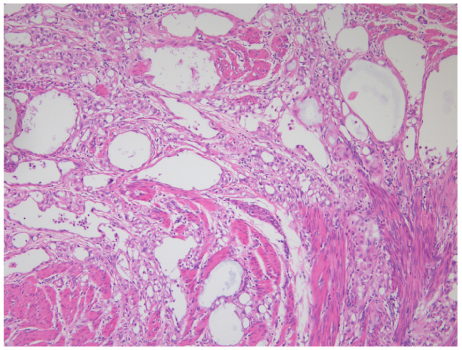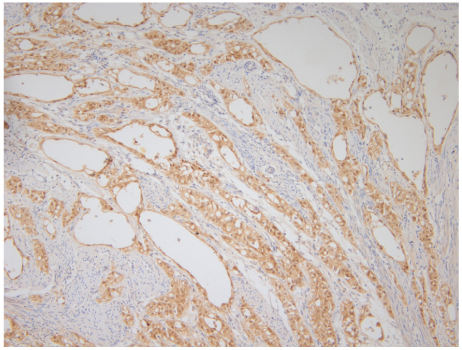Korean J Obstet Gynecol.
2010 Aug;53(8):714-719. 10.5468/kjog.2010.53.8.714.
Adenomatoid tumors of female genital tracts: An analysis of 195 cases
- Affiliations
-
- 1Department of Obstetrics and Gynecology, Cheil General Hospital and Women's Healthcare Center, Kwandong University College of Medicine, Seoul, Korea. jeanjane@naver.com
- 2Department of Pathology, Cheil General Hospital and Women's Healthcare Center, Kwandong University College of Medicine, Seoul, Korea.
- KMID: 2273989
- DOI: http://doi.org/10.5468/kjog.2010.53.8.714
Abstract
OBJECTIVE
Adenomatoid tumors of female genital tracts are benign lesions derived from mesothelium, occurring most commonly during the reproductive years. The aim of this study was to evaluate the overall incidence of adenomatoid tumors in Korean women and to analyze the clinical characteristics.
METHODS
One hundred and ninety five patients with adenomatoid tumors were found in a retrospective medical records review of pathologic reports for 44,984 benign uterine diseases at Cheil General Hospital, from January 1995 to April 2009.
RESULTS
The overall incidence rate was 0.42% of all benign uterine disease. Among them, 149 patients received hysterectomy, and 46 patients received uterine conservative surgery. Main symptoms of the patients were pain (25.1%), bleeding (30.2%), and palpable mass (18.5%). Most common associated pathologies were leiomyoma (46.6%), adenomyosis (25.1%) and endometriosis (13.1%). Most of the diagnosis was made postoperatively. Among 46 patients with conservative treatment, 13 patients showed successful pregnancy outcome. No recurrence occurred during the follow up period.
CONCLUSION
Adenomatoid tumors are associated with fibroids and tend to mimic them clinically, making pre-operative diagnosis difficult. The recurrence is rare even after conservative operation. Our data about this benign neoplasm may be helpful for counseling patients after operations.
MeSH Terms
Figure
Reference
-
1. Hanada S, Okumura Y, Kaida K. Multicentric adenomatoid tumors involving uterus, ovary, and appendix. J Obstet Gynaecol Res. 2003. 236:234–238.2. Golden A, Ash JE, Hinz M, et al. Adenomatoid tumors of the genital tract. Am J Pathol. 1945. 46:68–72.3. Di D, Faticanti L, Schaudig U, Covello R, Meli C, Bosman C, et al. Uterine diffuse adenomatoid tumor. Gynecol Obstet Invest. 1998. 46:68–72.4. Tiltman AJ. Adenomatoid tumours of the uterus. Histopathology. 1980. 4:437–443.5. Christensen C, Bichel P. Adenomatoid tumour of uterus. Br J Obstet Gynaecol. 1988. 95:524–526.6. Kalidindi M, Odejinmi F. Laparoscopic excision of uterine adenomatoid tumour: two cases and literature review. Arch Gynecol Obstet. 2010. 281:311–315.7. An SH, Cha SH, Kim MK, Kim JY, Choi GY, Lee JJ, et al. One case of adenomatoid tumor of uterus. Korean J Obstet Gynecol. 2009. 52:581–586.8. Lee IK Jr, Kim YD, Park YS, Park YH. Two cases of adenomatoid tumor. Korean J Obstet Gynecol. 1977. 20:859–862.9. Choi YH, Chae SW, Ahn HK, Lee MC, Park YE. Giant cystic adenomatoid tumor of the uterus: a case report. Korean J Pathol. 1993. 27:85–87.10. Kim MJ, Gu MJ. Giant cystic adenomatoid tumor of the uterus: a case report. Korean J Pathol. 2004. 38:415–418.11. Sangoi AR, McKenney JK, Schwartz EJ, Rouse RV, Longacre TA. Adenomatoid tumors of the female and male genital tracts: a clinicopathological and immunohistochemical study of 44 cases. Mod Pathol. 2009. 22:1228–1235.12. Nogales FF, Isaac MA, Hardisson D, Bosincu L, Palacios J, Ordi J, et al. Adenomatoid tumors of the uterus: an analysis of 60 cases. Int J Gynecol Pathol. 2002. 21:34–40.13. Schwartz EJ, Longacre TA. Adenomatoid tumors of the female and male genital tracts express WT1. Int J Gynecol Pathol. 2004. 23:123–128.14. Quigley JC, Hart WR. New insight into the pathophysiology of Primary acquired dacryostenosis. Am J Clin Pathol. 1981. 76:627–635.15. Huang CC, Chang DY, Chen CK, Chou YY, Huang SC. Adenomatoid tumor of the female genital tract. Int J Gynaecol Obstet. 1995. 50:275–280.16. Sieunarine K, Cowie AS, Bartlett JD, Lindsay I, Smith JR. A novel approach in the management of a recurrent adenomatoid tumor of the uterus utilizing a Strassman technique. Int J Gynecol Cancer. 2005. 15:671–675.17. Fisher ER, Klieger H. Epididymal carcinoma (malignant adenomatoid tumor, mesonephric,mesodermal carcinoma of epididymis). J Urol. 1966. 95:568–572.18. Irikoma M, Takahashi K, Kurioka H, Miyazaki K, Kamei T. Uterine adenomatoid tumors confirmed by immunohistochemical staining. Arch Gynecol Obstet. 2001. 265:151–154.



